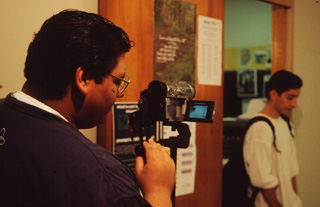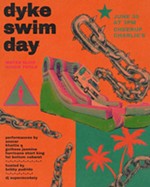Rethinking the Three R's
Reagan High's state-of-the-art digital media lab breeds a new batch of young filmmakers
By Rachel Proctor May, Fri., May 2, 2003

"All right, people," hollers Juan Pedraza. "Let's make it count this time!"
As Pedraza's voice echoes through the nearly empty hallway of Reagan High -- it's a Saturday morning -- Eric Corona adjusts his backpack and prepares for another take. The 16-year-old is the lead in "Eriko," a short narrative the 18-year-old Pedraza is shooting with his 16-year-old brother, Angel. Getting into character (he's playing a new student from Mexico), Corona slumps his slim shoulders with the weight of language barriers and loneliness. In this scene, he will bump into a Mexican-American student, played by Angel, and extend his hand in friendship, only to have it slapped away.
"You better watch where you're going, son," Angel will say before sauntering down the hall, tossing a snide "mojado" ("wetback") over his shoulder as his posse, consisting of Juan and second cameraman Mike Cueva, 17, slap his shoulders in approval. The three crack up as they throw on sweatshirts and pull knit caps low on their brows to transform themselves from mild-mannered filmmakers into a reasonably threatening-looking posse.
"Eriko" is one of two pieces from Reagan High slated to appear at the second Austin Student Film Festival, a screening of about 60 documentaries, music videos, animations, and narratives by elementary, middle, and high school students, showing May 3 at the Texas Union Theater. Every high school in Austin will be represented, from those with well-established digital-media programs such as Travis or Austin High, which alone submitted nearly half the festival entries, to schools whose media programs are just getting off the ground, like Reagan.
Reagan is an East Austin high school with 1,300 students, most of whom are minority and low-income. It is not the kind of school one generally imagines having a media lab humming with six G4 flat-screens, 15 iBooks, and four G4 laptops, a variety of editing software, and a fleet of camcorders -- at least not until recently. Over the past few years, efforts to combat a "digital divide" have brought a host of new technology to Austin schools, granting students access to cutting-edge equipment and new forms of self-expression. But at the same time, state and district budget-slashing threatens to undermine those very advances -- a situation that makes a festival celebrating school-aged filmmakers all the more valuable.
English teacher Trent Sharp launched Reagan's digital-filmmaking program in 2001 as a weekend class where students at risk for dropping out could earn English credit. At the time, the school had no equipment, and Sharp worked a deal with Cinemaker Co-op to rent cameras on the cheap. When the equipment for Reagan's digital-media lab arrived in fall 2002, Sharp began staying after school to teach moviemaking as a noncredit club.
In an educative environment that often emphasizes testing and discipline over creativity and independence, Sharp says that the club is about far more than learning how to set up lights or arrange clips.
"My kids are starving for a situation where they have freedom and are trusted with breakable equipment, as well as trusted to tell their own stories," Sharp explains. "And when I just shut up and get out of the way, the things they come up with are more honest and funny and truthful than anything I could push them to do."
While the films the students proposed making for the festival included the gleeful adolescent exuberance one might expect -- celebrations of skateboarding, a blue-Slurpee-brain-freeze-psycho-killer flick -- several groups also proposed surprisingly heavy topics. Fifteen-year-olds Ruthie Cyril and Lenae Hutchinson, for example, decided to tackle teen pregnancy in "Just Once," the other Reagan film that will screen at the festival.
"I was walking down the hall with Lenae, and she was like, 'There's just too many girls pregnant,'" explained Cyril. She and Hutchinson were leaning over a stack of sketches of their scenes, explaining their plans to Sharp.
"So, we're not sure about the end," Hutchinson said. "We wanted to give her a second chance, but didn't want her to have an abortion."
"Yeah, that's a pretty controversial topic," said Sharp.
"It's just ... we didn't want it to be gruesome. So we're thinking she has a miscarriage."
The chance to tell a story meaningful to them also brought the Pedrazas to the club, Juan and Angel explained as they worked on editing their half-hour of footage into a five-minute narrative.
"Another kid told me he wanted to make a movie about the struggles and isolation of a kid from Mexico," Angel explained. "And I just ran away with his idea."
Juan glanced away from the monitor, on which played one of their 24 takes of a flower "blowing" (courtesy of fishing line) to Corona's feet as a symbol of hope. "When Angel told me about the idea, I wanted to get involved," he added. "I still remember what it was like to have a hard time speaking in English."
"But the idea was the easy part," sighed Angel, who had taken a few days off his full-time job at Popeye's Chicken -- the brothers are largely self-supporting -- to edit. Then he perked up. "Hey, that take's not bad. You can hardly see the wire at all."
Because few students have the time to devote to a noncredit club, Sharp is excited that this fall he will be able to offer a digital-filmmaking class that fulfills the technology credits AISD requires of all schools -- and offers his students more of a challenge.
"Once this becomes a credit course instead of a club, I'll have students shoot oral histories and documentaries about East Austin," he said. "No skateboarding movies unless somebody's got a grandfather who skates."
That digital filmmaking merges art and technology is fortuitous in a budget-slashing era when many see traditional arts as fartsy frivolity but see digital arts as a valuable job skill. As of 2002, all the high schools in Austin now enjoy a digital-media lab like Reagan's, courtesy of a state Telecommunications Infrastructure Board, or TIF, grant for five high schools, money that AISD matched to outfit the rest. Jeff Meyer, AISD's director of instructional technology, explained that while many teachers beef up their labs by writing grants to federal agencies or private foundations, it is TIF that provided the majority of AISD's hardware and Internet access.
Teachers at those schools already offering courses like digital filmmaking, Web design, or desktop publishing rave about the doors they open for their students. One such school is Travis High, whose communications academy offers specialized tracks including multimedia, filmmaking, journalism, and programming. Their multimedia program dates back to 1994, when teacher Keith Rutledge wrote a federal grant to purchase the initial equipment. Now, says Rutledge, Travis students master skills that allow many to pursue internships, build Web sites for clients, or develop virtual tours for museums, all while earning their diplomas.
But Rutledge, who also helped found the Austin Student Film Fest, points out that communications courses are also of value to students with no intention of launching a career.
"We get a lot of nontraditional learners, kids who learn visually," Rutledge said. "These are students who might not do well in other classes, and working with media gives them something they can enjoy and excel at."
But despite the obvious value of digital-media programs, many still may not survive Texas' obvious shortage of funds. The legislation that created TIF has a sunset clause, meaning that TIF must be explicitly renewed by the Legislature to continue. Losing TIF, Meyer warns, could easily grind these programs to a halt.
"Computers have a three- to five-year life span," he said. "So if TIF went away for a year or two we'd be OK, but after that we'd really start hurting."
District-level cuts can hurt such programs as well. Rutledge points out that the recent cut of a district school-to-career program could mean the loss of some federal Perkins funds, simply for lack of someone to fill out the paperwork. Likewise, Meyer explains that cutting support positions could cripple some programs.
"Technology is important, but it's not a core-content area, so when principals have to cut staff, one place they look is technology-support staff," he said. "But we're in a position where many teachers are just starting to feel comfortable with this equipment, so it would be heartbreaking to lose the support element just now."
Teachers like Sharp and Rutledge hope the successes of their programs, and events like the festival, will help keep technology funds flowing. Watching from across the room as Juan and Angel keep plowing through editing, Sharp explained his hope that technology, mixed with creativity on the part of teachers, could help those students the current system is failing.
"A pen can't teach you to write," he said. "And all this equipment is worth nothing unless you put it to use. But fortunately we're in an age when being able to tell a story visually is incredibly relevant, whether through filmmaking, photography, or Web design. It's rigorous and engaging, and a real alternative for schools where the kids aren't relating to Hamlet." ![]()
The Austin Student Film Festival begins at 4pm on Saturday, May 3, at the Texas Union Theater (UT Campus, Texas Union Building, second level) with films by elementary and junior high students; films by high school students, including Reagan High's "Eriko" and "Just Once," begin at 7pm. Admission is free.










